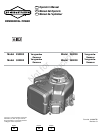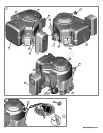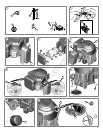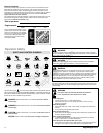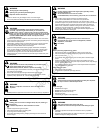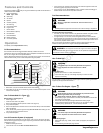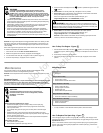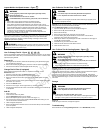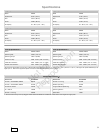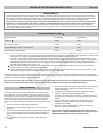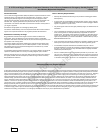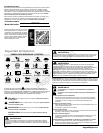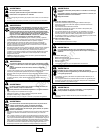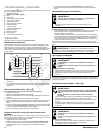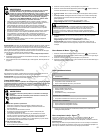
7
en
POISONOUS GAS HAZARD. Engine exhaust contains carbon
monoxide, a poisonous gas that could kill you in minutes. You
CANNOT see it, smell it, or taste it. Even if you do not smell exhaust
fumes, you could still be exposed to carbon monoxide gas. If you start
to feel sick, dizzy, or weak while using this product, shut it off and get
to fresh air RIGHT AWAY.See a doctor. You may have carbon
monoxide poisoning.
WARNING
Operate this product ONLY outside far away from windows, doors and vents to
reduce therisk of carbonmonoxide gas fromaccumulating and potentiallybeing
drawn towards occupied spaces.
Install battery--operated carbon monoxide alarms or plug--in carbon monoxide
alarms with battery back-up according to the manufacturer’s instructions.
Smoke alarms cannot detect carbon monoxide gas.
DO NOT run this product inside homes, garages, basements, crawlspaces,
sheds, or other partially-enclosed spaces even if using fans or opening doors
and windows for ventilation. Carbon monoxide can quickly build up in these
spaces and can linger for hours, even after this product has shut off.
ALWAYS place this product downwind and point the engine exhaust away from
occupied spaces.
NOTICE: This engine was shipped from Briggs & Stratton without oil. Before you start
the engine, make sure you add oil according to the instructions in this manual. If you
start the engine without oil, it will be damaged beyond repair and will not becovered
under warranty.
Note: Some engines and equipment have remote controls. See the equipment manual
for location and operation of remote controls.
1. Check the oil level. See the How To Check/Add Oil section.
2. Make sure equipment drive controls, if equipped, are disengaged.
3. Turn the fuel shut-off valve (A), if equipped, to the on position (Figure 3).
4. Push the stop switch (F), if equipped, to the on position.
5. Move the throttlec ontrol (B)tothefast
position. Operate the enginein the fast
position.
6. Rewind Start: Turn the key switch (D), if equipped, to the run position.
7. Rewind Start: Firmly hold the starter cord handle (E). Pull the starter cord handle
slowly until resistance is felt, then pull rapidly.
Note: If the engine does not start after repeated attempts, go to
VanguardEngines.com or call 1-800-999-9333 (in USA).
WARNING: Rapid retraction of the starter cord (kickback) will pull your
hand and arm toward the engine faster than you can let go. Broken bones, fractures,
bruises or sprains could result. When startingengine, pull the startercord slowly until
resistance is felt and then pull rapidly to avoid kickback.
8. Electric Start: Turn the electric start switch (D) to the on/start position.
Note: If the engine does not start after repeated attempts, go to
VanguardEngines.com or call 1-800-999-9333 (in USA).
NOTICE: To extend thelife of the starter, use short starting cycles (five seconds
maximum). Wait one minute between starting cycles.
How To Stop The Engine - Figure
3
1. With the throttle control (B) in the slow position, turn the key switch (D)tothe
off position (Figure 3). Remove the key and keep in a safe place out of the reach of
children.
2. Push the stop switch (F) to the off position.
3. After the engine stops, turn the fuel shut-off valve (A), if equipped, to the closed
position.
Maintenance
We recommend that you see any Briggs & Stratton Authorized Dealer for all
maintenance and service of the engine and engine parts.
NOTICE: All the components used to build this engine must remain in place for proper
operation.
Emissions Control
Maintenance, replacement, orrepair of theemissions control devices and systems
may be performed by any non-road engine repair establishment or individual.
However, to obtain “no charge” emissions control service, the work must be performed
by a factory authorized dealer. See the Emissions Warranty.
Unintentional sparking can result in fire or electric shock.
Unintentional start-up can result in entanglement, traumatic
amputation, or laceration.
Fire hazard
WARNING
Before performing adjustments or repairs:
Disconnect the spark plug wire and keep it away from thespark plug.
Disconnect battery at negative terminal (only engines with electric start.)
Use only correct tools.
Do not tamper with governor spring, links or other parts to increaseengine
speed.
Replacement parts must be of the same design and installed in the same
position as the original parts. Other parts may notperform as well, may damage
the unit, and may result in injury.
Do not strike the flywheel with a hammer or hard object becauset he flywheel
may later shatter during operation.
When testing for spark:
Use approved spark plug tester.
Do not check for spark with spark plug removed.
Maintenance Chart
First 5 Hours
Change oil
Every8HoursorDaily
Check engine oil level
Clean area around muffler and controls
Every 100 Hours or Annually
Clean or change air filter *
Change engine oil and filter
Replace spark plug
Check muffler and spark arrester
Every 250 Hours or Annually
Check valve clearance. Adjust if necessary.
Every 400 Hours or Annually
Clean air cooling system *
Clean oil cooler fins *
* In dusty conditions or when airborne debris is present, clean more often.
How To Replace The Spark Plug - Figure
4
Check the gap (A, Figure 4) with a wire gauge (B). If necessary, reset the gap. Install
and tightenthe sparkplug to the recommendedtorque. For gapsetting ortorque, seethe
Specifications section.
Note: In some areas, local law requires using a resistor spark plug to suppress ignition
signals. If this engine was originally equipped with a resistor spark plug, use the same
type for replacement.
Not for
Reproduction



